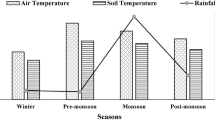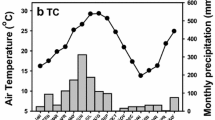Abstract
The present study was undertaken to determine soil respiration and its relation with some soil or weather variables under pine plantation forest located at Atoizu town (Zunheboto district), bamboo plantation at Khensa village (Mokokchung district) and rubber plantation in Yongam village (Longleng district) of Nagaland. The maximum soil respiration was recorded during winter while the minimum value was exhibited during the rainy season both from rubber plantation. Soil respiration was positively correlated with atmospheric temperature, soil temperature and pH in all the sites. Among all the parameters, only soil bulk density was significantly different between the three plantation sites (Pine-rubber, pine-bamboo and rubber-bamboo). Overall, the results obtained from the experiments provided a better understanding of soil respiration affinity with soil or weather variables under pine, bamboo and rubber forest which would ultimately help researchers in improving the efforts to quantify the carbon sink potential in these pockets of ecosystem.
Similar content being viewed by others
Data Availability
Data made available on reasonable request.
References
Raich JW, Tufekciogul A (2000) Vegetation and soil respiration: correlations and controls. Biogeochem 48:71–90
Lal R (2003) Soil erosion and the global carbon budget. Environ Intern 29(4):437–450
Meyer N, Welp G, Amelung W (2018) The temperature sensitivity (Q10) of soil respiration: controlling factors and spatial prediction at regional scale based on environmental soil classes. Glo Biogeochem Cycle 32:306–323
Lang R, Blagodatsky S, Xu J, Cadisch G (2017) Seasonal differences in soil respiration and methane uptake in rubber plantation and rainforest. Agric Ecosyst Environ 240:314–328
Oishi AC, Palmroth S, Butnor JR, Oren JKH, R, (2013) Spatial and temporal variability of soil CO2 efflux in three proximate temperate forests ecosystems. Agric For Meteor 172:256–269
Takahashi M (2011) Topographic variation in heterotrophic and autotrophic soil respiration in a tropical seasonal forest in Thailand. Soil Sci Plant Nutri 57:452–465
Chang SC, Tseng KH, Hsia YJ, Wang CP, Wu JT (2008) Soil respiration in a subtropical montane cloud forest in Taiwan. Agric For Meteor 148:788–798
Richards AE, Dathe J, Cook GD (2012) Fire interacts with season to influence soil respiration in tropical Savannas. Soil Bio Biochem 53:90–98
Yashiro Y, Shizu Y, Adachi T, Ohtsuka T, Lee N, Iimura Y, Koizumi H (2012) The effect of dense understory dwarf bamboo (Sasa senanensis) on soil respiration before and after clear cutting of cool temperate deciduous broad-leaved forest. Eco Res 27:577–586
Mielnick PC, Dugas WA (2009) Soil CO2 flux in a tall grass praire. Soil Biol Biochem 32:221–228
Semy K, Singh MR (2021) Quality assessment of Tsurang River water affected by coal mining along the Tsurangkong Range, Nagaland. India Appl Water Sci 11:115
Kirita H (1971) Re-examination of the absorption method of measuring soil respiration under field conditions: II effect of the size of the apparatus on CO2 absorption rates. Japan J Ecol 21:37–42
Walkley A, Black IA (1934) An examination of the detjareff method for determining soil organic matter and a proposed modification to the chronic acid titration method. Soil Sci 37:29–38
Blake GR, Hartge KH (1986) Bulk density: methods of soil analysis. Part I: physical and mineralogical methods. ASA-SSA. Madison, USA. Agro Mono 9:363–375
Kuzyakov Y (2005) Theoretical background for partitioning of root and rhizomicrobial respiration by 13C of microbial biomass. Europ J Soil Biol 41:1–9
Kukumagi M, Ostonen I, Kupper P, Truu M, Tulva I, Varik M, Aosaar J, Sober J, Lohmus JS (2014) The effects of elevated atmospheric humidity on soil respiration components in a young silver birch forest. Agric For Manag 194:167–174
Wang W, Chen W, Wang S (2010) Forest soil respiration and its heterotrophic and autotrophic components: global patterns and responses to temperature and precipitation. Soil Bio Biochem 42:1236–1244
Davidson EA, Janssens IA (2006) Temperature sensitivity of soil carbon decomposition and feedbacks to climate change. Nature 440:165–173
Liu J, Jiang PK, Wang HL, Zhou GM, Wu JS, Yang F, Qian XB (2011) Seasonal soil CO2 efflux dynamics after land use change from a natural forest to Moso bamboo plantations in subtropical China. For Eco Manage 262:1131–1137
Tang X, Fan S, Qi L, Guan F, Cai C, Du M (2015) Soil respiration and carbon balance in a Moso bamboo (Phyllostachys heterocycla (Carr.) Mitford cv. Pubescens) forest in subtropical China. Biogeosci For 8:606–614
Bhaishya J, Sharma S (2017) Analysis of physic-chemicals properties of soil under different land use system with special reference to agro ecosystem in Dimoria Development Block of Assam. India Int J Sci Res Edu 5(6):6526–6532
Tripathi R, Singh AK (2004) Effect of water and nitrogen management on aggregate size and carbonbon enrichment of soil in rice-wheat crop** system. J Plant Nutri Soil Sci 167:216–228
Euskirchen ES, Chen J, Gustafson EJ, Ma S (2003) Soil respiration at dominant patch types within a managed northern Wisconsin landscape. Ecosyst 6:595–607
Semy K, Singh MR, Vats N (2021) Evaluation of soil quality of a coal mine affected forest at Changki, Nagaland, India. J Environ Eng Lands Manag 29:381–390
McEligott KM (2017) Soil respiration and decomposition dynamics of loblolly pine (Pinus taeda L.) plantations in the Virginia Piedmont. Ph. D thesis submitted to the Virginia Polytechnic Institute and State University, p. 125
Wang C, Yang J, Zhang Q (2006) Soil respiration in six temperate forests in China. Glob Change Biol 12:2103–2114
Florinsky I, Eilers RG, Manning GR, Fuller LG (2002) Prediction of soil properties by digital terrain modelling. Environ Model Soft 17(3):295–311
Kaspar T, Bland WL (1992) Soil temperature and root growth. Soil Sci 154:290–299
Semy K, Singh MR, Walling M, Temjen W, Jangir A, Mishra G (2022) Qualitative soil assessment of coal mine disturbed and undisturbed tropical forest in Nagaland, India. Pro Nat Acad Sci India B Bio Sci. https://doi.org/10.1007/s40011-021-01343-x
Acknowledgements
Financial funding from UGC-SAP DRS-III to the Department of Botany, Nagaland University, Lumami, is highly acknowledged. The authors wish to acknowledge the Head, Department of Botany, for providing us with the laboratory and chemical facilities to carry out the analyses.
Funding
Not applicable.
Author information
Authors and Affiliations
Contributions
KS contributed to field experiments and manuscript preparations. RK contributed to construction of the manuscript. MRS contributed to supervision of the experiments. LAP, VC, and PK contributed to field experiments and laboratory works.
Corresponding author
Ethics declarations
Conflict of interest
The authors declare that they have no conflict of interest.
Consent for Publication
All authors have their consent to publish their work.
Consent to Participate
All authors have their consent to participate.
Ethical Approval
Not applicable.
Additional information
Publisher's Note
Springer Nature remains neutral with regard to jurisdictional claims in published maps and institutional affiliations.
Significance Statement: Different types of forests impart diverse ecosystems and play a significant role in carbon sequestration including global climate regulation. Thus, the study highlights the variation of soil respiration in respect to some environmental variables under pine, bamboo and rubber plantation forest stands in Nagaland.
Rights and permissions
Springer Nature or its licensor (e.g. a society or other partner) holds exclusive rights to this article under a publishing agreement with the author(s) or other rightsholder(s); author self-archiving of the accepted manuscript version of this article is solely governed by the terms of such publishing agreement and applicable law.
About this article
Cite this article
Semy, K., Singh, M.R., Kuotsu, R. et al. Changes in Soil and Weather Variables at Different Plantation Forests in Nagaland, India. Proc. Natl. Acad. Sci., India, Sect. B Biol. Sci. 93, 843–850 (2023). https://doi.org/10.1007/s40011-023-01468-1
Received:
Revised:
Accepted:
Published:
Issue Date:
DOI: https://doi.org/10.1007/s40011-023-01468-1




